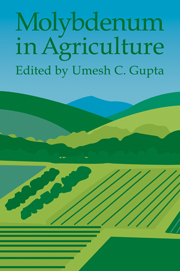Book contents
- Frontmatter
- Contents
- List of contributors
- Preface
- 1 Introduction
- 2 Chemistry and Mineralogy of Molybdenum in Soils
- 3 Distribution and Mobility of Molybdenum in the Terrestrial Environment
- 4 Biochemical Significance of Molybdenum in Crop Plants
- 5 Soil and Plant Factors Affecting Molybdenum Uptake by Plants
- 6 Analytical Techniques for Molybdenum Determination in Plants and Soils
- 7 Testing for Molybdenum Availability in Soils
- 8 Molybdenum Availability in Alkaline Soils
- 9 Deficient, Sufficient, and Toxic Concentrations of Molybdenum in Crops
- 10 Symptoms of Molybdenum Deficiency and Toxicity in Crops
- 11 Sources and Methods for Molybdenum Fertilization of Crops
- 12 Yield Responses to Molybdenum by Field and Horticultural Crops
- 13 Responses of Forage Legumes and Grasses to Molybdenum
- 14 Molybdenum and Sulfur Relationships in Plants
- 15 Molybdenum in the Tropics
- Index
10 - Symptoms of Molybdenum Deficiency and Toxicity in Crops
Published online by Cambridge University Press: 10 December 2009
- Frontmatter
- Contents
- List of contributors
- Preface
- 1 Introduction
- 2 Chemistry and Mineralogy of Molybdenum in Soils
- 3 Distribution and Mobility of Molybdenum in the Terrestrial Environment
- 4 Biochemical Significance of Molybdenum in Crop Plants
- 5 Soil and Plant Factors Affecting Molybdenum Uptake by Plants
- 6 Analytical Techniques for Molybdenum Determination in Plants and Soils
- 7 Testing for Molybdenum Availability in Soils
- 8 Molybdenum Availability in Alkaline Soils
- 9 Deficient, Sufficient, and Toxic Concentrations of Molybdenum in Crops
- 10 Symptoms of Molybdenum Deficiency and Toxicity in Crops
- 11 Sources and Methods for Molybdenum Fertilization of Crops
- 12 Yield Responses to Molybdenum by Field and Horticultural Crops
- 13 Responses of Forage Legumes and Grasses to Molybdenum
- 14 Molybdenum and Sulfur Relationships in Plants
- 15 Molybdenum in the Tropics
- Index
Summary
Introduction
The symptoms of molybdenum (Mo) deficiency are common in certain crops under certain soil and climatic conditions. However, Mo toxicity is uncommon and is found only when unusually high concentrations of Mo are present.
Deficiency symptoms for most micronutrients appear on the young leaves at the top of the plant, because most micronutrients are not readily translocated. Molybdenum is an exception in that it is readily translocated, and its deficiency symptoms generally appear on the whole plant.
The symptoms associated with deficiency of Mo are closely related to nitrogen (N) metabolism. Because Mo is needed for nitrogenase activity, Mo deficiency prevents the fixation of N2. This process involves higher plants and symbiotic organisms such as Rhizobium, and so Mo deficiency can produce symptoms associated with a deficiency of nitrogen. If the Mo is needed directly by the plant for nitrate reductase, then symptoms peculiar to Mo occur, although essentially the plant can be considered to be suffering from a shortage of protein due to failure of the initial processes of reduction.
The first type of symptom can be relieved by supplying fixed nitrogen. Even may serve the purpose, because the Mo requirement for nitrate reductase is lower than that for nitrogenase.
- Type
- Chapter
- Information
- Molybdenum in Agriculture , pp. 160 - 170Publisher: Cambridge University PressPrint publication year: 1997
- 23
- Cited by



